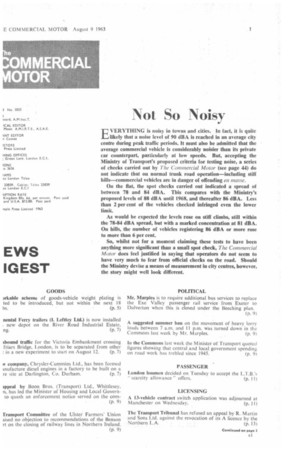Not So Noisy
Page 3

If you've noticed an error in this article please click here to report it so we can fix it.
VERYTHING is noisy in towns and cities. In fact, it is quite likely that a noise level of 90 dBA is reached in an average city centre during peak traffic periods. It must also be admitted that the average commercial vehicle is considerably noisier than its private car counterpart, particularly at low speeds. But, accepting the Ministry of Transport's proposed criteria for testing noise, a series of checks carried out by The Commercial Motor (see page 44) do not indicate that on normal trunk road operation—including stiff hills—commercial vehicles are in danger of offending en masse.
On the flat, the spot checks carried out indicated a spread of between 78 and 84 dBA. This compares with the Ministry's proposed levels of 88 dBA until 1968, and thereafter 86 dBA. Less than 2 per cent of the vehicles checked infringed even the lower limit.
As would be expected the levels rose on stiff climbs, still within the 78.84 dBA spread, but with a marked concentration at 81 dBA. On hills, the number of vehicles registering 86 dBA or more rose to more than 6 per cent.
So, whilst not for a moment claiming these tests to have been anything more significant than a small spot check, The Commercial Motor does feel justified in saying that operators do not seem to have very much to fear from official checks on the road. Should the Ministry devise a means of measurement in city centres, however, the story might well look different.
































































































































